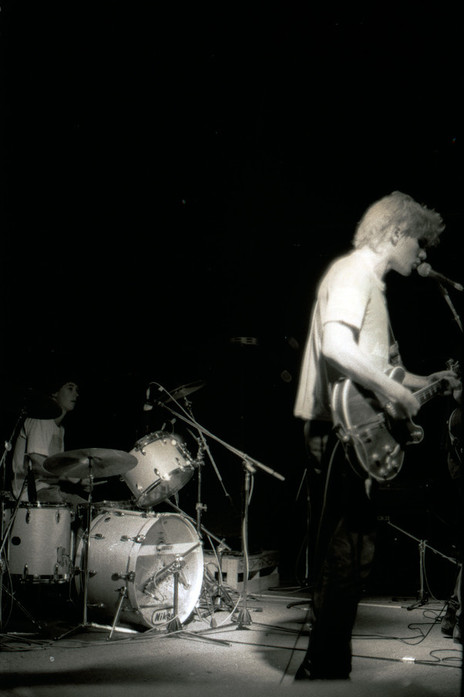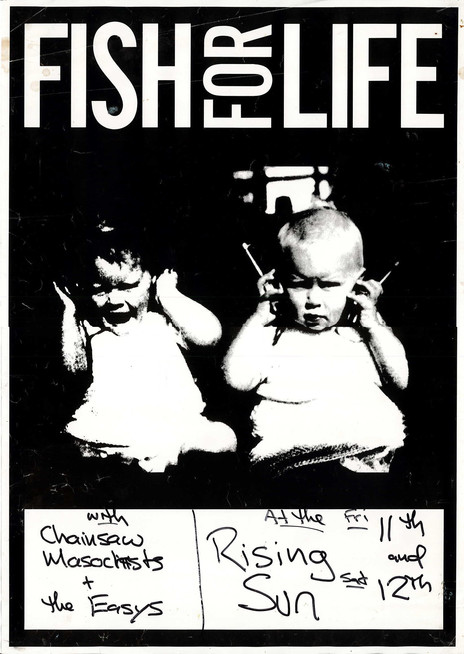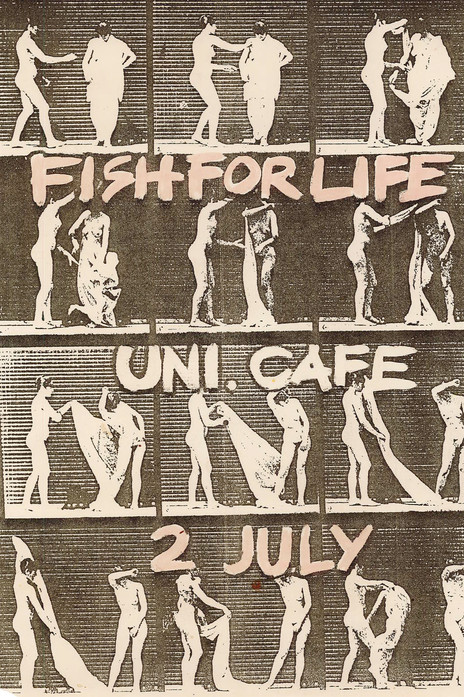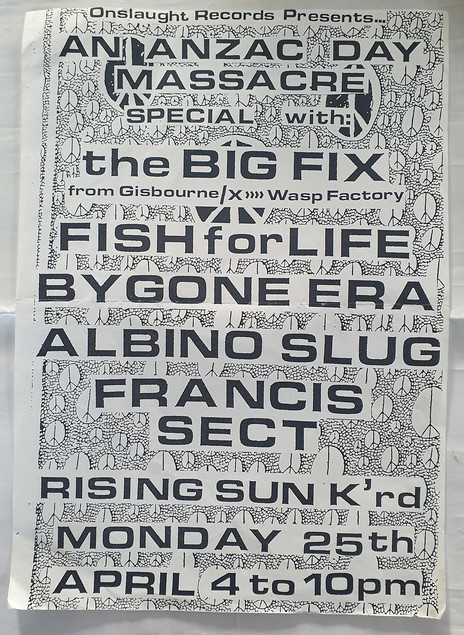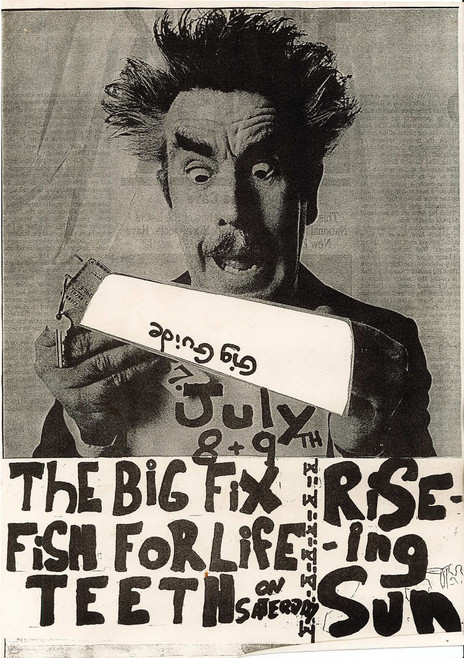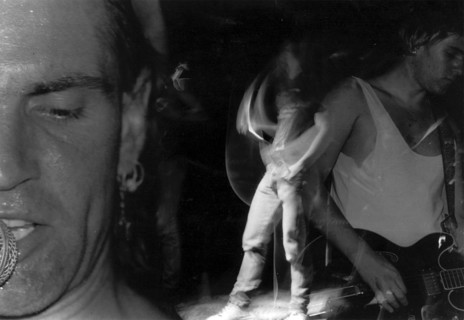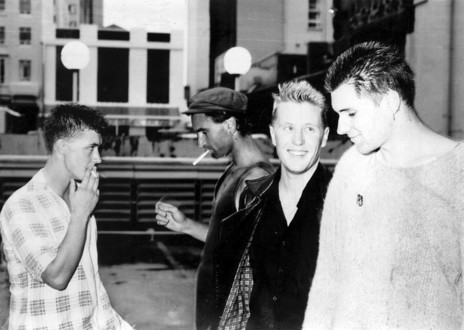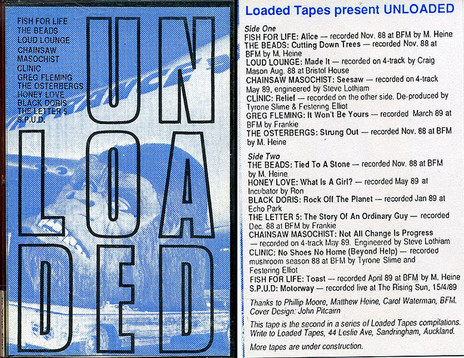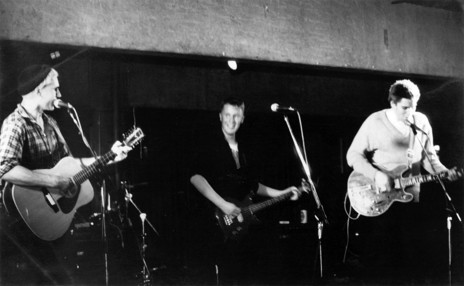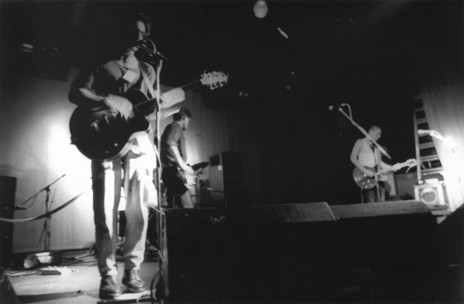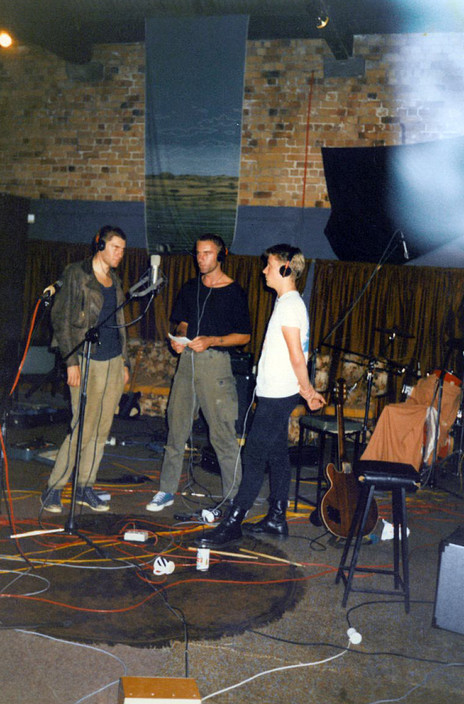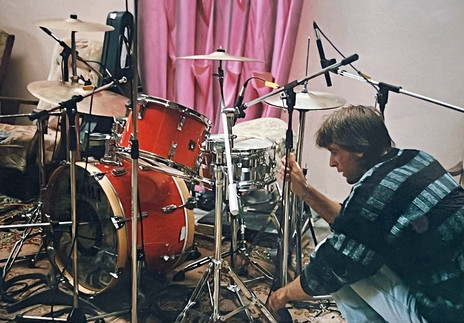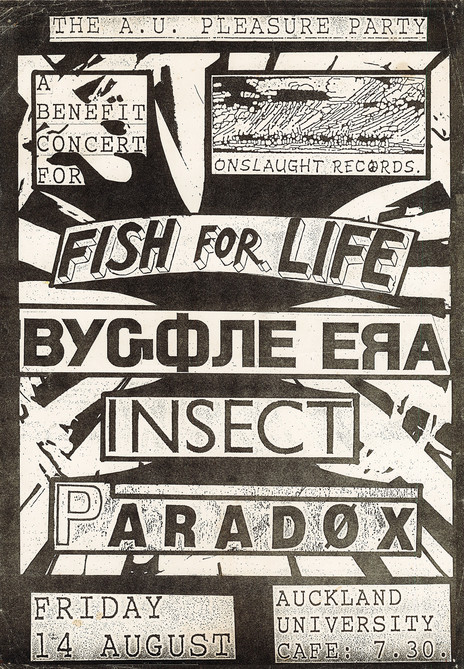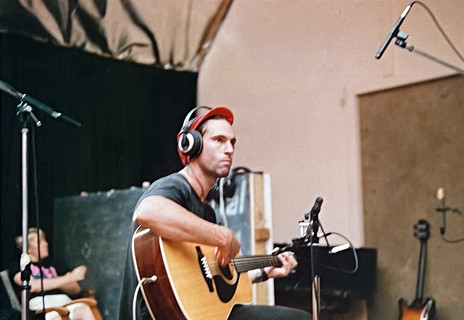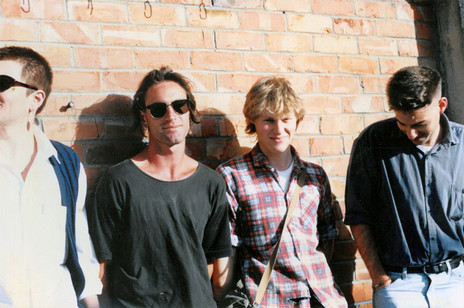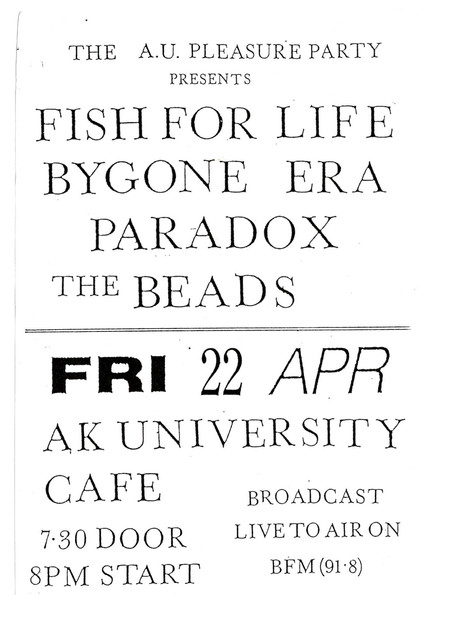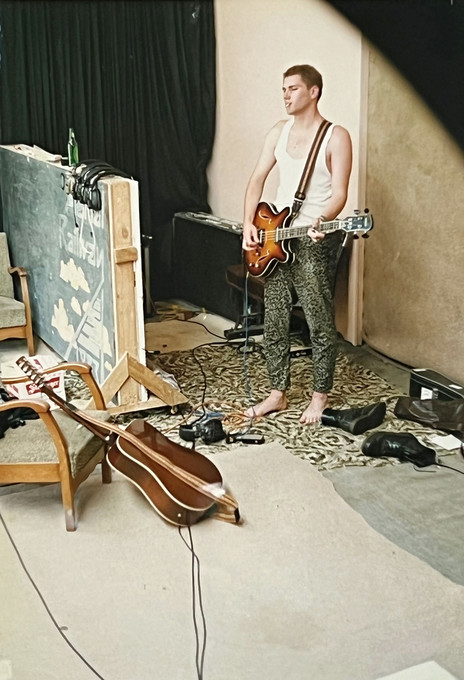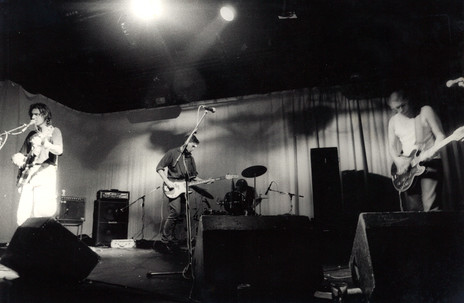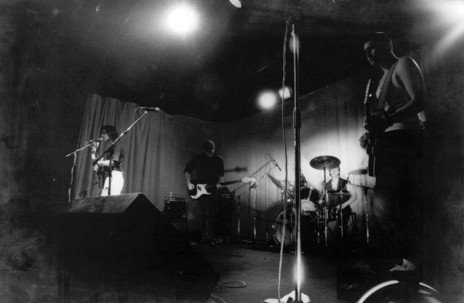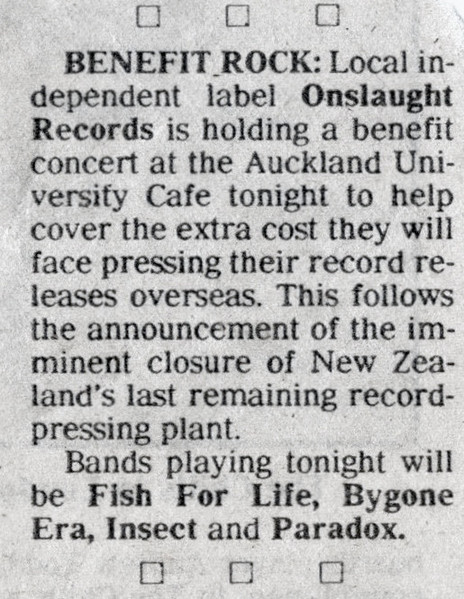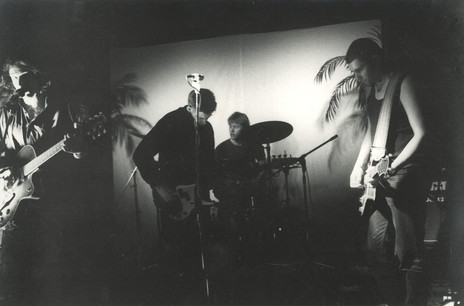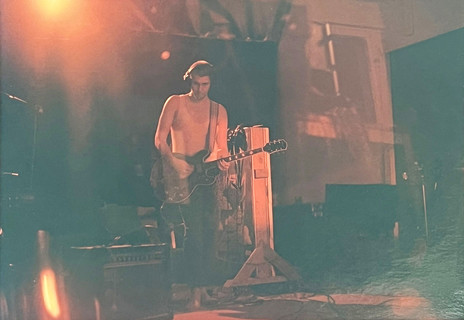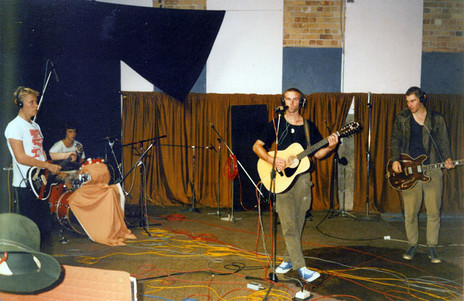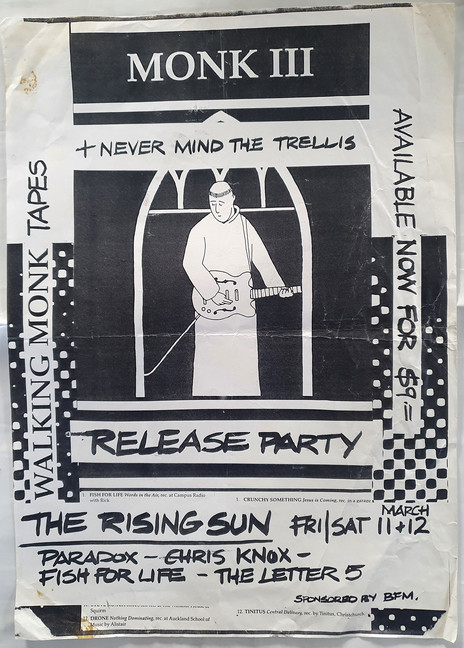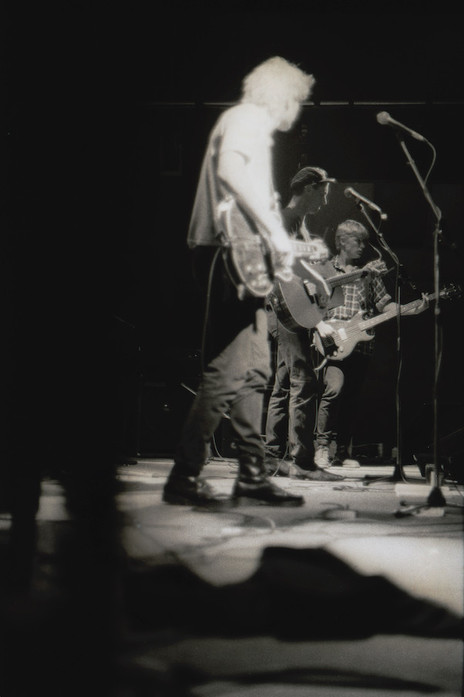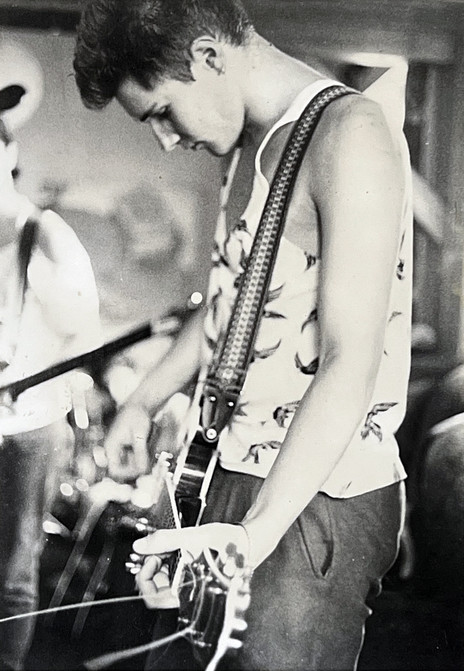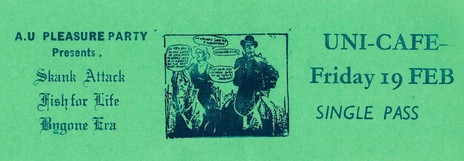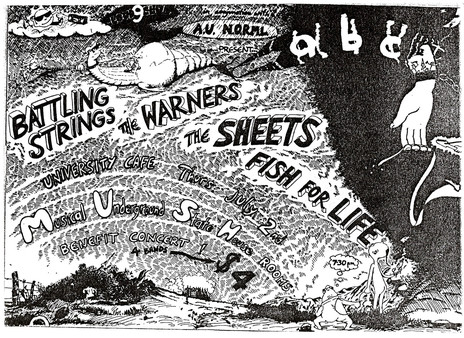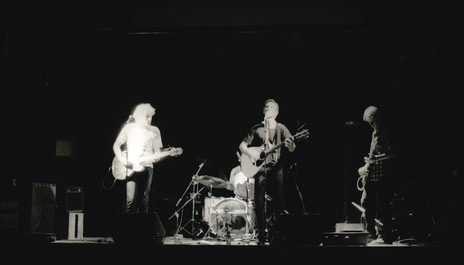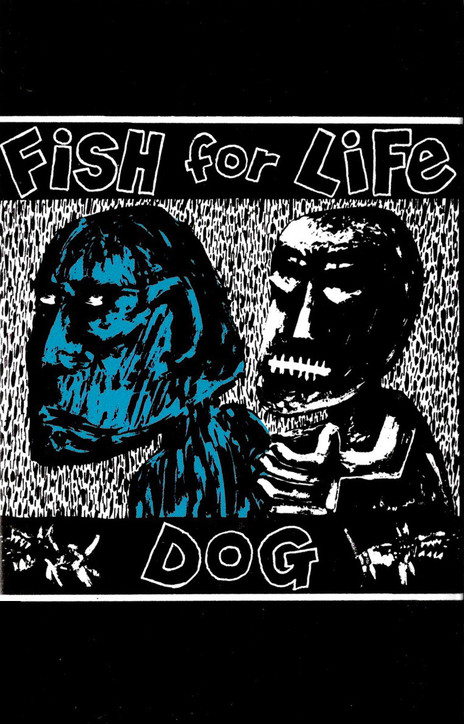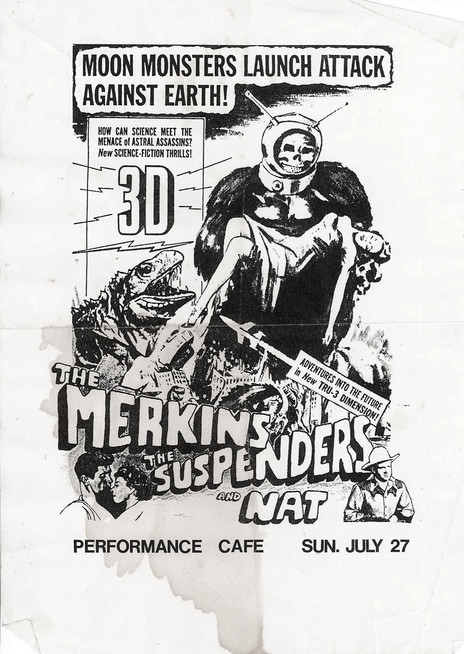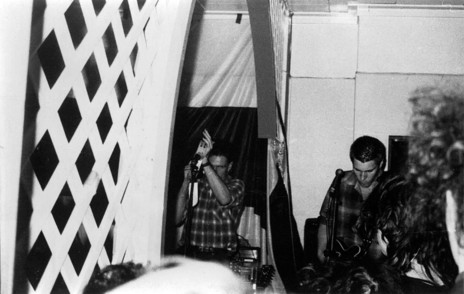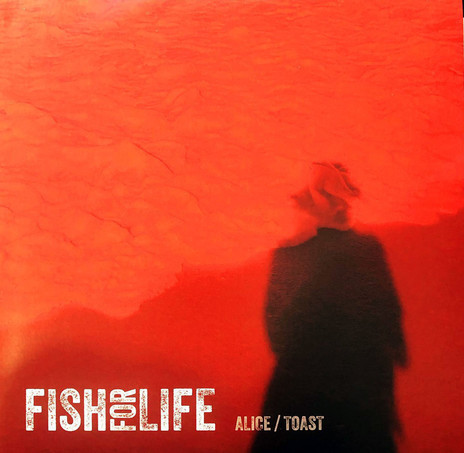He laughs when I asked if they ever played with Youth For Christ. “I always wanted to, that would have been fun! Especially if we’d hired a church hall on a Sunday afternoon.”
Nat had been gigging by himself for some time, wandering about with his guitar and talking his way into playing his songs between bands at the Windsor Castle and other Auckland venues. His brother Barnaby (Barney) was in a band called The Merkins with Jonathan King (bass), Martin Bell (vocals and keyboards) and Russell Gibb (drums), which began while they were all at Northcote College.
There was a rich mix of talent in Northcote, with connections that would resurface in notable ways.
The Merkins coveted a spot in the practice room behind the Highbury Shopping Centre in Birkenhead with K4, Goblin Mix, Exploding Budgies, Flak, and contemporaries Paradox. The Merkins were the newbies, the slightly star-struck younger kids in awe of the local heroes they were occasionally sharing a space with.
There was a rich mix of talent in Northcote, with connections that would resurface in notable ways. The Battling Strings for example, featured Jonathan King’s sister Rachael (The Cakekitchen), along with David Saunders (The 3Ds), Mike Shepherd, and (Goblin Mix’s Philip Moore’s younger brother) Andy Moore (Battling Strings, Cane Slide, notable music video and documentary maker, National Junior Skateboard Champion 1979). The Merkins had their first recording experience at The Lab in its Fanshawe Street incarnation, engineered by Glenn Eisenhut from the Exploding Budgies.
Barney Curnow: “We used to go and see the Budgies play, there were at least a half-dozen bands at school who were gigging. It was insane.”
The Merkins were gigging a fair bit themselves, playing at The Performance Cafe in Symonds Street, and The Rising Sun on K Rd. They were 18, old enough to play to drinking punters, but not allowed to drink themselves.
Nat Curnow: “I played a couple of shows with The Merkins. They were a fun band, they used to play a sloppy version of ‘Pull Down The Shades’ (The Enemy/Toy Love) and Chris Knox jumped out of the audience and joined in at one gig. So I hung around playing support slots, and it wasn’t long before I was playing second guitar in The Merkins. Someone, probably me, suggested we try one of my songs, which became more of my songs, then the sound started to change, and we changed the name. I officially became part of the band around 1985.”
Jonathan King: “We had been playing two or three years before Nat joined. We were quite chuffed he was interested in joining, he came with good songs and a confident singing voice.”
Siblings in a band together can be problematic, but in this case Nat and younger brother Barney got on like a house on fire.
Barney: “Nat was living in places like the Big House in Parnell, and places in Grafton, and I’d go and visit him and go to parties and stuff when I was far too young, really. My parents would have been horrified if they’d known what I was getting up to at that age. I was going to see bands at the Windsor Castle when I was 15. So I had quite an early introduction to gigs and parties because of my older brother leading me astray.”
It’s worth noting an unusually rich arts pedigree going on in this line-up. Jonathan’s dad was the late historian and writer Michael King, while Nat and Barney’s dad is Wystan Curnow the art critic, early champion of the modern movement in New Zealand. Their grandfather was the eminent poet Allen Curnow.
A 1987 National Student Radio Compilation titled Spins and Needles (Pagan, 1988) was their first showing, with the song ‘Sacred’. They joined an interesting cross-section of locals including Francis Sect, Cuban War Poets, and The Magic Roundabout on a release that sadly suffered from a terrible pressing, the low audio levels ruining a potentially important release.
Their tune was recorded at bFM in the AUSA building, but this wasn’t Nat’s first time in a studio. “I’d done recordings of my solo stuff at The Lab, Last Laugh, and with a guy called Mick Ray who had a studio in Mount Albert,” he says. “He was a fairly eccentric English guy, he lives in the desert in Nevada and drives trucks for a living now.”
Simon Coffey released the1988 Dog EP on cassette via his Onslaught label. He had been organising gigs at the Auckland University Cafe and using the money raised to fund a half dozen vinyl-only local releases over the previous 18 months featuring bands such as Bygone Era, The Warners, and Guava Groove (featuring future documentary maker Dan Salmon and a young Nathan Haines).
They were excited by the prospect of releasing a record, but events conspired against them.
The songs for Dog were recorded at the Aerial Railway Studio in the Coromandel and The Lab in July 1988 (except ‘Words In The Air’ recorded at bFM in 1987, which also appeared on the Walking Monk 3 compilation that same year). The band had an enjoyable experience at Aerial Railway but discovered when they started mixing the tracks that the snare drum track had been deleted – they had to overdub it song by song. Martin Bell hadn’t made the transition to Fish For Life but contributed keyboards to the recordings.
They were excited by the prospect of releasing a record, but events conspired against them. Polygram had dismantled their pressing plant in Wellington, so Coffey had The Warners album pressed in Sydney. He decided that the associated costs and difficulties were worth it and had already paid for the pressing of the Fish For Life album as well as a compilation titled Chop! Chop! Chop! (1988, which also featured the band) when the Sydney office announced they were closing their pressing plant as well (these were market-driven decisions, driving local consumers towards CDs). Coffey had to tell the band it was going to be a cassette-only release, which took the wind out of their sails.
Russell Gibb and Jonathan King left the band not long afterwards. They recall announcing they were leaving while each of the Curnow brothers remembers events differently. Either way, it was amicable.
Nat: “Barney and I broke the band up with the intent of getting a new rhythm section, because we weren’t happy with the sound. We’d toured with [Wellington band] Skank Attack who had just parted ways. The bass player Jeff [Eden] had just moved to Auckland, I asked him to come around for a jam and it was just fantastic. We’d played with Matthew Heine’s band Albino Slug quite a bit, and I think Matthew wanted to do something a little different. I had no idea he played the drums, but he sat in and was just this thunderingly-good drummer ... so we’d found ourselves a new band.”
Nat often wrote songs as sketches of ideas, and the process of arrangement grew out of the collective’s various approaches to playing.
Nat: “Barney would come up with guitar melodies, counterpoints to my vocal ones, and the good thing about Jeff was that he was an unconventional bass player, he played it like a guitar with chords and open notes, so we had these big bass melodies as well. And this fed back into the songwriting, because these two would bring whole other melodic levels into the mix. It took the pressure off me writing all the parts and became more of a collaborative process. I struggled with that at times, being a songwriter, I tended to be a bit autocratic. Matthew seemed to really enjoy stepping back from his songwriter role in Albino Slug and just playing drums, and he and Jeff played together so well – the band just became a different thing. It lifted the joy level of playing.”
Fish For Life, along with a significant number of their peers, got themselves justifiably worked up for the Neon Picnic, a massive three-day event at the end of January 1988 that was cancelled moments before it began. Local representation was going to be high, and the Auckland contingent of student radio-centric acts had prepared in advance. Nat’s flat was full of gear, beer, and party favours aplenty (FFL were the first act on the bill), so when word came through the show was off it was decided a party was the best response.
The second line-up recorded four songs at BFM in 1989.
Nat: It would have been really good exposure for everybody, and the opportunity to play on a bigger stage than the Powerstation or Mainstreet was exciting. There were a few bands, NRA was one, that went down to the gig and set up and played anyway, but we thought well fuck it we have all the gear, the bands, the booze, let’s have a non-Neon Picnic here! The Ngauruhoe Street flat was a classic party villa, huge living room and hallway plastered with band posters, a scrappy back yard full of dog shit and cigarette butts. The Battling Strings played, various Headless Chickens were at the party, though some of them were playing away with NRA, members of the Sheets were there, the Warners possibly ... the memory is a bit hazy because the party was so good!”
The second line-up recorded four songs at BFM in 1989: ‘Alice’, ‘Toast’, ‘Newest’, and ‘Bookshop’. ‘Alice’ and ‘Toast’ were the only songs released from those sessions, on another Onslaught cassette-only compilation. Fish For Life developed a distinctive sound, their own take on a new melodic branch of post-punk.
Barney: My girlfriend and I were flatting with Nat in Mount Eden, and I remember the day that he brought home The Wedding Present album, George Best, and though I can’t remember the timing of that I often think of Fish For Life in that context.”
This off-kilter Celtic aspect of Fish For Life is evident on a recording from the mixing desk at a Powerstation gig that captures the band hitting their stride – Jeff and Matthew’s rhythm section propelling things along, their brakes-off downhill momentum framing Barney’s lead lines which weave around Nat’s confident, sometimes strident vocal. Nat played a Maton semi-acoustic, and Barney’s guitar was a semi-acoustic Epiphone Riviera, so there were some widescreen guitar tones colouring their tunes.
The band had a good live reputation and was getting radio play, but they had no manager and no one in the band was pushing things along. One day Nat decided a course of action on everyone’s behalf.
Nat: “I decided to go to London. Being brutally honest I’d say my opinion of myself was higher than I was worthy of ... I decided I wanted to travel and just bailed. We were getting good audiences and really enjoying it, but I guess I was just not really taking it too seriously, so I’m off to seek my fortune. I had a great life, working on the bar at the Powerstation, a great girlfriend, a really good band, but I threw some things in a bag and fucked off. Ended up in London in the winter sleeping on a concrete floor and feeling sorry for myself.”
Fish For Life finished things off with a wild last gig at the Rising Sun. Nat and Barney’s mum had brought their youngest brother to the show, their cousin Simon was playing in The Malchicks, and their brother Ben was playing in a duo called The Suspenders with Nick Hanson (The Spelling Mistakes). They all joined FFL onstage for a rousing version of Pere Ubu’s ‘Non-alignment Pact’ as the crowd went wild, and the police raided the premises accompanied by a new Minister of Police and a TV News camera crew.
Matthew Heine was already playing guitar in S.P.U.D., and Nat’s leaving pretty much coincided with them losing their other guitarist Matthew Hyland, so naturally Barney stepped in to fill the gap.
Barney: “That was quite full on, they were booked to go into The Lab. I think I had a couple of weeks to learn the songs, and those funny time signatures... they were one of my favourite bands at the time, I thought they were amazing. I must have been affected by Nat heading off, but I really don’t recall. I was glad when he came back!”
Aftermath: Nat Curnow is currently living in Melbourne and making music with Catherine O’Dwyer (Fatal Jelly Space) under the name The Specks. Barney Curnow is a VFX Supervisor in the UK and plays in the band Big Name Hunters. Jonathan King is a filmmaker and played guitar with Wellington band The Dickens. Russell Gibb is an archaeologist.
--
Fish For Life’s 7 single Alice b/w Toast was released in 2022, and can be heard, along with two other tracks, on Bandcamp. Future releases may include unreleased tracks from the bFM studio, along with a handful of live tunes recorded at the Powerstation.
